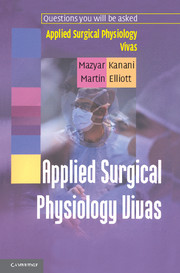Book contents
- Frontmatter
- Contents
- List of Abbreviations
- Dedication
- Preface
- A Change in Posture
- Acid-Base
- Action Potentials
- Adrenal Cortex I
- Adrenal Cortex II – Clinical Disorders
- Adrenal Medulla
- Arterial Pressure
- Autonomic Nervous System (ANS)
- Carbon Dioxide Transport
- Cardiac Cycle
- Cardiac Output (CO)
- Cell Signalling
- Cerebrospinal Fluid (CSF) and Cerebral Blood Flow
- Colon
- Control of Ventilation
- Coronary Circulation
- Fetal Circulation
- Glomerular Filtration and Renal Clearance
- Immobilization
- Liver
- Mechanics of Breathing I – Ventilation
- Mechanics of Breathing II – Respiratory Cycle
- Mechanics of Breathing III – Compliance and Elastance
- Mechanics of Breathing IV – Airway Resistance
- Microcirculation I
- Microcirculation II
- Micturition
- Motor Control
- Muscle I – Skeletal and Smooth Muscle
- Muscle II – Cardiac Muscle
- Nutrition: Basic Concepts
- Pancreas I – Endocrine Functions
- Pancreas II – Exocrine Functions
- Potassium Balance
- Proximal Tubule and Loop of Henle
- Pulmonary Blood Flow
- Renal Blood Flow (RBF)
- Respiratory Function Tests
- Small Intestine
- Sodium Balance
- Sodium and Water Balance
- Starvation
- Stomach I
- Stomach II – Applied Physiology
- Swallowing
- Synapses I – The Neuromuscular Junction (NMJ)
- Synapses II – Muscarinic Pharmacology
- Synapses III – Nicotinic Pharmacology
- Thyroid Gland
- Valsalva Manoeuvre
- Venous Pressure
- Ventilation/Perfusion Relationships
Pancreas I – Endocrine Functions
Published online by Cambridge University Press: 06 January 2010
- Frontmatter
- Contents
- List of Abbreviations
- Dedication
- Preface
- A Change in Posture
- Acid-Base
- Action Potentials
- Adrenal Cortex I
- Adrenal Cortex II – Clinical Disorders
- Adrenal Medulla
- Arterial Pressure
- Autonomic Nervous System (ANS)
- Carbon Dioxide Transport
- Cardiac Cycle
- Cardiac Output (CO)
- Cell Signalling
- Cerebrospinal Fluid (CSF) and Cerebral Blood Flow
- Colon
- Control of Ventilation
- Coronary Circulation
- Fetal Circulation
- Glomerular Filtration and Renal Clearance
- Immobilization
- Liver
- Mechanics of Breathing I – Ventilation
- Mechanics of Breathing II – Respiratory Cycle
- Mechanics of Breathing III – Compliance and Elastance
- Mechanics of Breathing IV – Airway Resistance
- Microcirculation I
- Microcirculation II
- Micturition
- Motor Control
- Muscle I – Skeletal and Smooth Muscle
- Muscle II – Cardiac Muscle
- Nutrition: Basic Concepts
- Pancreas I – Endocrine Functions
- Pancreas II – Exocrine Functions
- Potassium Balance
- Proximal Tubule and Loop of Henle
- Pulmonary Blood Flow
- Renal Blood Flow (RBF)
- Respiratory Function Tests
- Small Intestine
- Sodium Balance
- Sodium and Water Balance
- Starvation
- Stomach I
- Stomach II – Applied Physiology
- Swallowing
- Synapses I – The Neuromuscular Junction (NMJ)
- Synapses II – Muscarinic Pharmacology
- Synapses III – Nicotinic Pharmacology
- Thyroid Gland
- Valsalva Manoeuvre
- Venous Pressure
- Ventilation/Perfusion Relationships
Summary
1. What are the three cell types found in the pancreas' Islets of Langerhans, and what do they secrete?
α-cells: secrete glucagon
β-cells: secrete insulin
δ-cells: secrete somatostatin
2. Other than insulin and glucagon, which other hormones may influence the serum [glucose]?
There are several, but the most important are:
Catacholamines: epinephrine and norepinephrine
Glucocorticoids: most important being cortisol
Somatotrophin: a pituitary hormone
All of the above increase serum [glucose]. The only hormone that is known to decrease serum [glucose] is insulin.
3. What are the possible metabolic fates for glucose molecules in the body?
Glycolysis: they may be metabolised by glycolysis and then to the tricarboxylic acid (TCA) cycle following the production of pyruvate
Storage: as glycogen, through the process of glycogenesis. Most tissues of the body are able to do this
Protein glycosylation: this is a normal process by which proteins are tagged with glucose molecules. This is by strict enzymatic control
Protein glycation: this is where proteins are tagged with glucose in the presence of excess circulating [glucose]. It is not enzymatically controlled unlike the above example. An example of this is glycosylated haemoglobin
Sorbitol formation: this occurs in various tissues when glucose enters the polyol pathway that ultimately leads to the formation of fructose from glucose
4. Where do the body's glucose molecules come from?
The diet
Glycogenolysis: following the breakdown of glycogen
Gluconeogenesis: this is the generation of glucose from non-carbohydrate precursors
[…]
- Type
- Chapter
- Information
- Applied Surgical Physiology Vivas , pp. 111 - 114Publisher: Cambridge University PressPrint publication year: 2004



